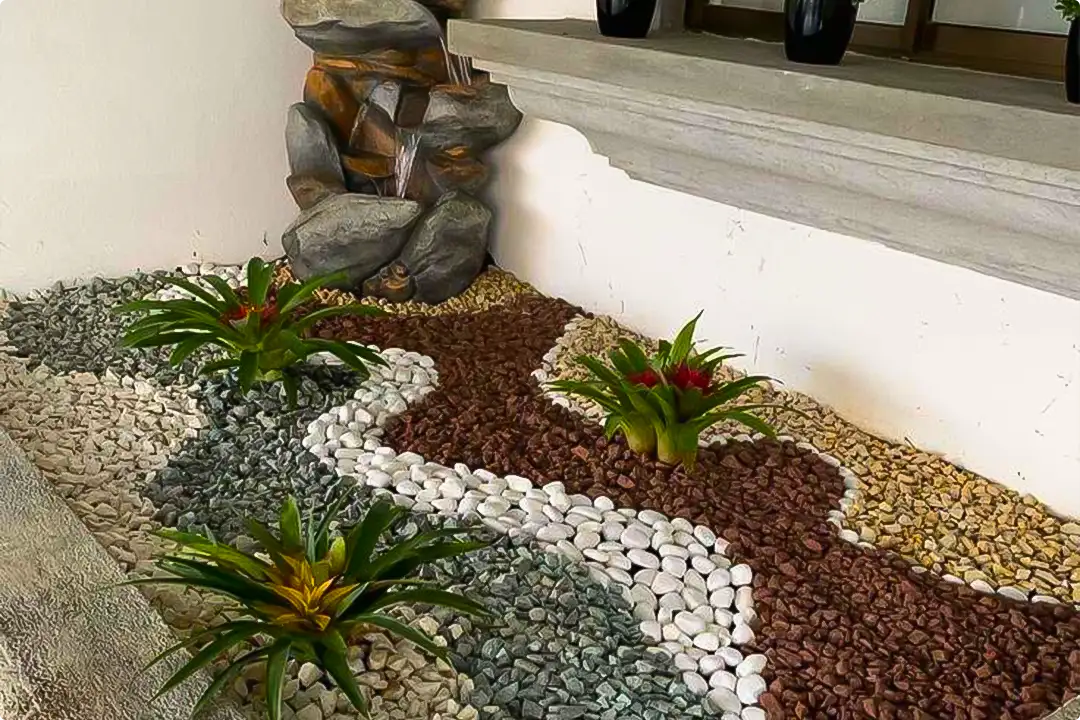
Pebbles are basically the unsung heroes of garden design. They add texture, color, and a finished look that mulch just can’t compete with.
The best part? They’re low-maintenance. No mowing, no constant watering, just rocks doing their thing while looking good.
You can use them to create effortless pathways, define seating areas, or just fill in those awkward gaps where nothing seems to grow.
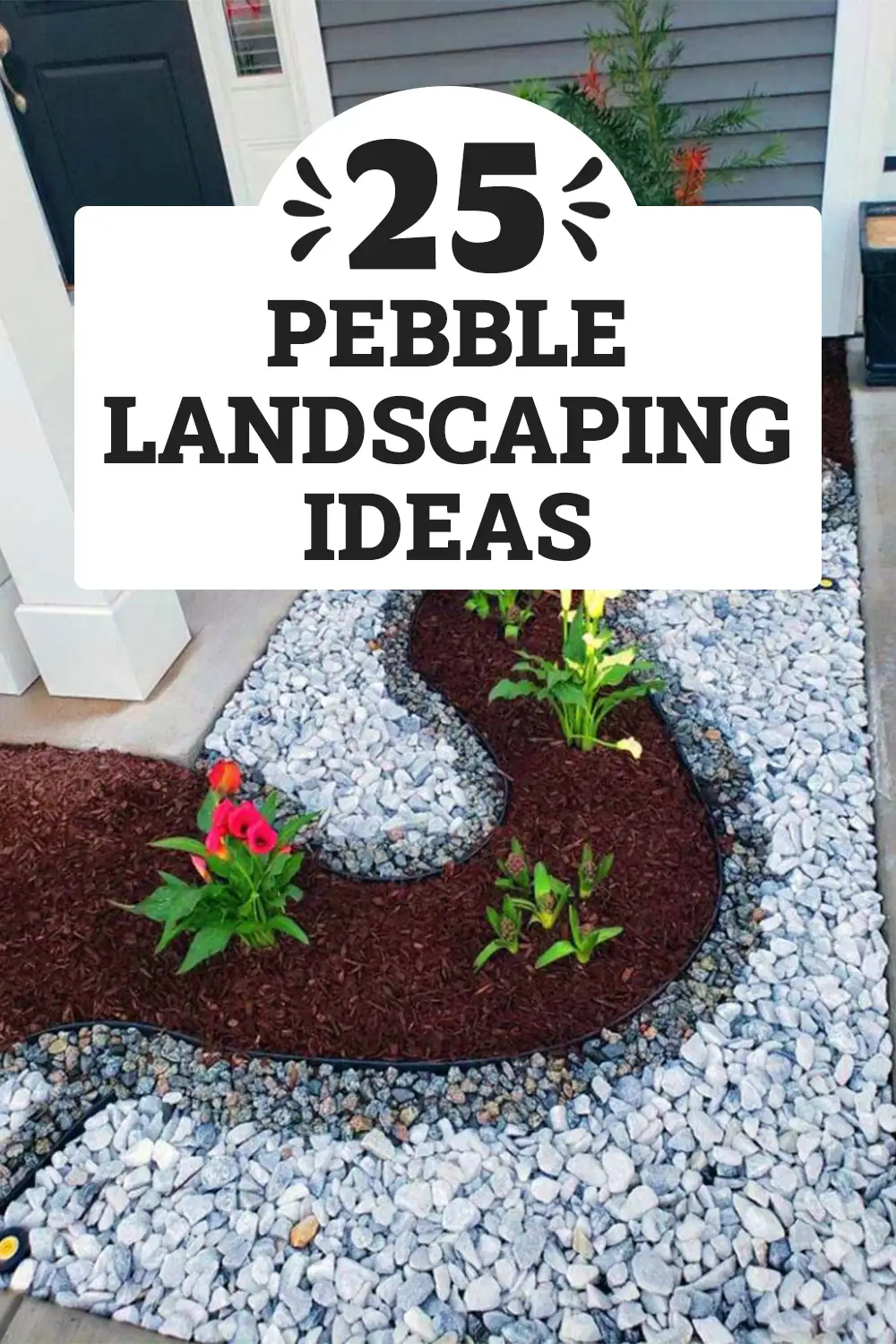
It’s an easy weekend project that completely changes how your outdoor space feels. They come in all sorts of colors and sizes, so you can match them to pretty much any style.
Plus, they are low maintenance, which is always a bonus in my book. Check out these pebble landscaping ideas to see how you can transform your yard.
Related Articles:
- 20 Front Yard Texas Native Landscaping Ideas
- 19 Rock Front Yard Landscaping Ideas
- 19 Brilliant Front of House Landscaping Ideas
Evening Glow with Fire and Stone

That fire pit sitting in a bed of dark pebbles is the kind of thing that makes you want to be outside at night.
The whole setup has these curving pebble pathways that guide you through the space. Some parts are lighter, some darker, and it all flows together.
Those uplights around the plants and trees? They turn the whole yard into something special after sunset.
The stepping stones make it easy to walk around without messing up the rocks. And honestly, mixing the fire element with all those cool tones from the pebbles just works.
Stepping Stones Through the Side Yard

Big round stepping stones set into white pebbles make a simple pathway that actually looks good.
The gray stones pop against all that white gravel. It’s an easy pattern to follow with your eyes.
Those small trees planted along the side add some green without taking up much space. The whole thing turns a boring side yard into something you’d actually want to walk through.
Spilled Pot Water Feature

A terracotta pot tipped on its side with white pebbles spilling out like water is such a fun idea.
The white stones flow through brown pebbles and larger rocks to create that “stream” effect. It’s playful but still looks put together.
Pair it with some potted succulents in turquoise planters and you’ve got a little garden moment. Plus that starfish accent just adds to the whole vibe.
Winding Garden Borders

White pebbles used as a curving border around your garden beds create instant definition.
The wavy line separates the dark soil from everything else and makes each planting area stand out. Those terracotta pots with spiky plants look even better sitting in their own little pebble rings.
It’s a clean look that doesn’t need much maintenance. The contrast between white stones and dark earth does all the work.
Yin Yang Garden Design
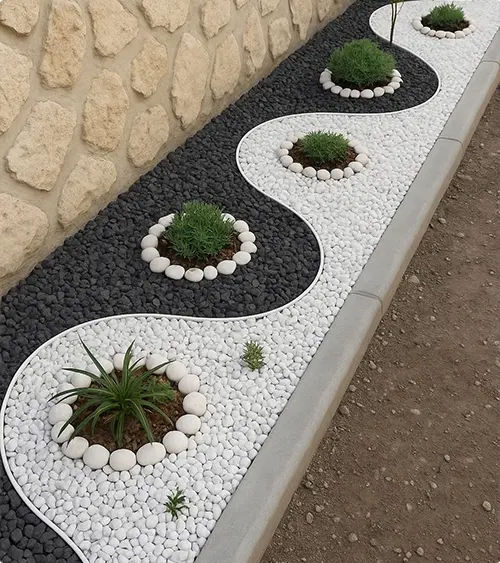
Black and white pebbles arranged in a flowing yin yang pattern is bold.
Each section gets its own plant circled with white stones, sitting in either the black or white pebble areas. The whole thing has this calm, balanced feeling.
It’s definitely a conversation starter. And the best part is you can see the design from above if you have a second-story window.
Curved Pebble Pathway
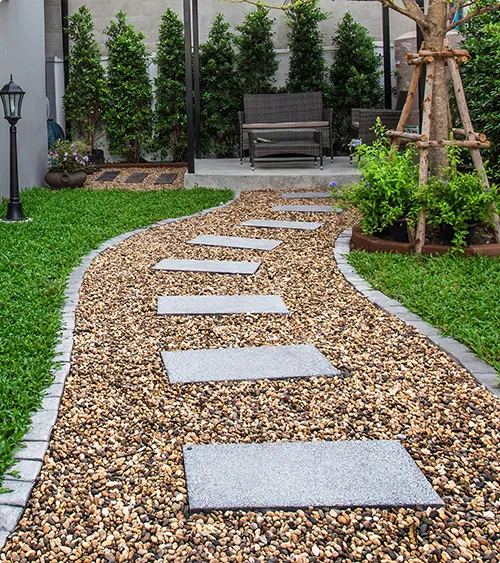
A gently curving path made of tan pebbles with concrete pavers is simple but effective.
The curve makes your yard feel bigger than it is because your eye follows that line. Those flat stones give you a solid place to step.
Edge it with some white stones or lawn, add a seating area at the end, and you’ve created a reason to walk through your garden. It’s functional and pretty at the same time.
Modern Front Yard Drama

White pebbles flowing between mulched planting areas in waves creates serious curb appeal.
The modern home deserves a modern landscape, and this delivers. Each succulent and agave gets its own mulch island surrounded by those bright white stones.
The repetition of the wave pattern pulls the whole design together. It’s low-water and low-maintenance, which is always a win.
Autumn Spillover Display
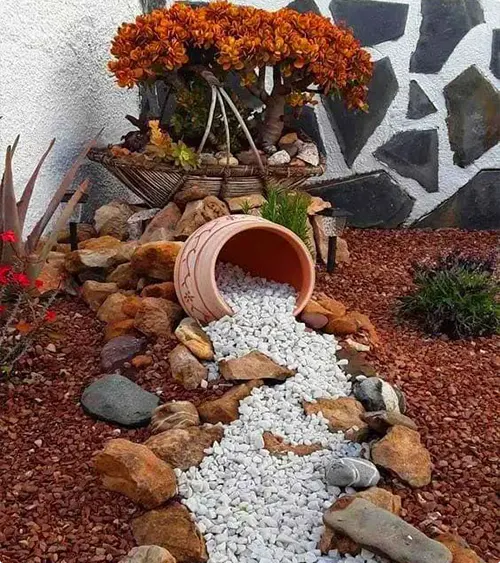
A terracotta pot spilling white pebbles with fall mums and a decorative wheelbarrow brings seasonal charm.
The white stones flow around natural rocks and into the red mulch like a little stream. It’s cottage-style landscaping with an autumn twist.
That tipped pot adds height and draws your eye up to the flowers. Everything feels intentional but not too perfect.
Succulent Spill Feature
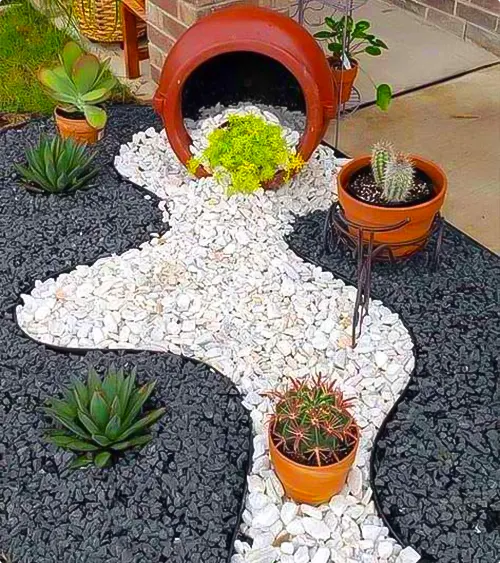
Another tipped pot idea, but this time with succulents and dark pebbles as the base.
White stones pour out and create a river through the black gravel. Terracotta pots with cacti sit right in the flow.
That pop of yellow-green succulent in the pot adds just enough color. It’s a desert vibe without being too literal about it.
Wheelbarrow Garden Corner
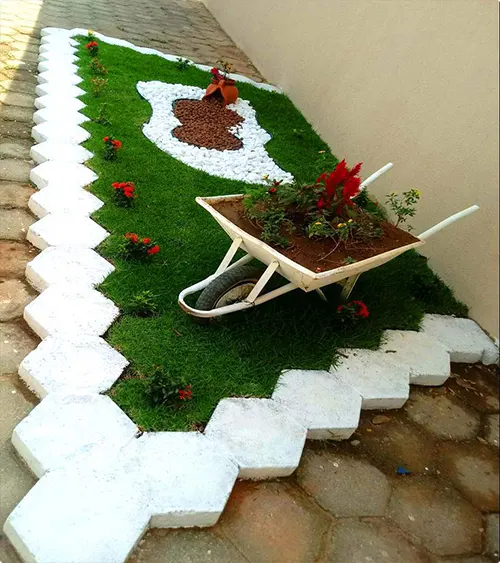
A decorative wheelbarrow sitting on white pebbles with brown mulch accents is cottage garden goals.
The zigzag border made of white stones separates different sections. Grass, white pebbles, and brown mulch all get their own space.
Those red flowers add the color you need. And the wheelbarrow gives the whole thing a farmhouse feel without trying too hard.
Black Wicker Borders
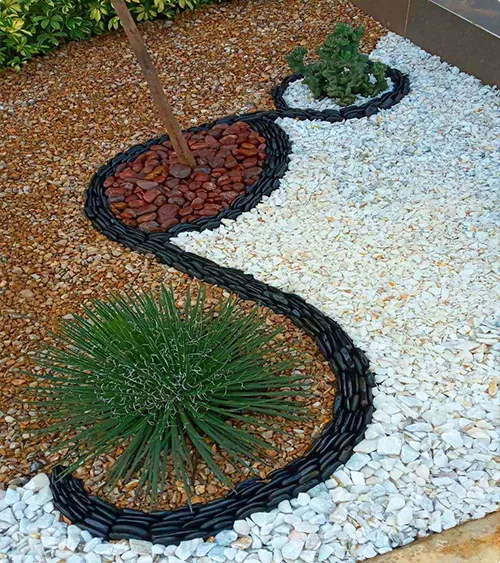
Using black wicker edging to create circular sections filled with different colored pebbles is surprisingly cool.
You get white stones, brown stones, and tan stones all in one design. Each circle holds a different plant and a different color.
The black borders keep everything separated and defined. It’s like a pebble sampler that actually looks intentional.
Clay Pebble Overflow
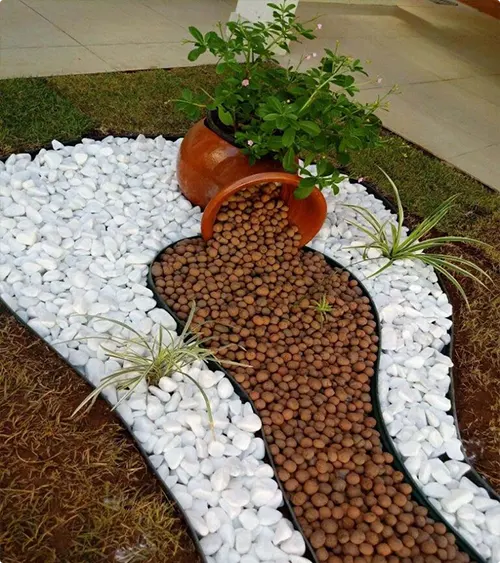
A terracotta pot tipped over with tan pebbles spilling out onto white stones is warm and welcoming.
The contrast between the two pebble colors creates that stream effect. Add a little greenery poking through and you’re done.
It’s such an easy project but it looks like you spent way more time on it than you did.
Indoor Pebble Garden
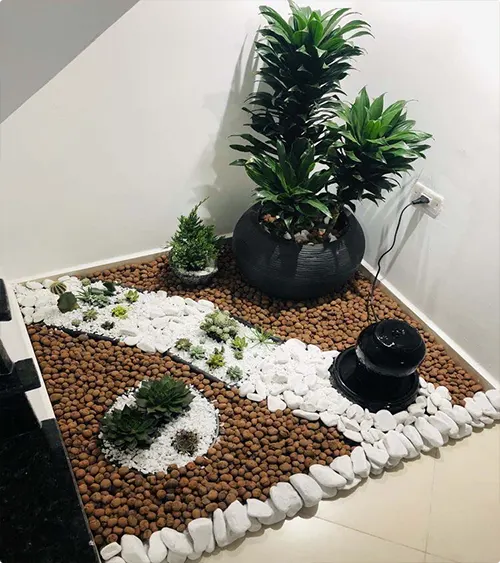
White pebbles and brown clay balls create a miniature landscape inside your home.
Black pots with lush green plants sit right in the pebbles like little islands. The clay balls add texture and a different color.
That white stone border around the edge frames the whole thing. It brings the outdoors in without the mess of actual soil.
Front Entry Curves
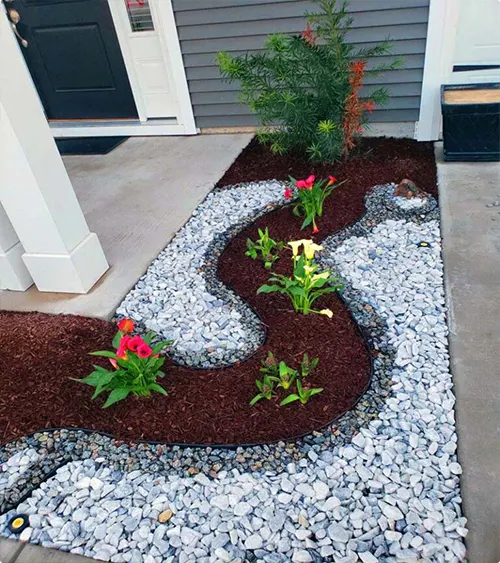
A flowing design using white pebbles and dark mulch guides visitors to your front door.
The S-curve pattern is simple but makes the small space feel designed. Those pops of pink and yellow flowers break up all the neutral tones.
It’s low-maintenance landscaping that doesn’t look boring. Plus it hides any bare spots in the yard.
Rainbow Pebble Mosaic

Different colored pebbles arranged in sections with a stone water feature is like garden art.
You’ve got white, gray, brown, tan, and probably a few other colors all working together. Each section flows into the next without feeling chaotic.
Those tropical plants add the green you need to balance all the stone. The little fountain ties it all together with some movement and sound.
Zen Backyard Journey
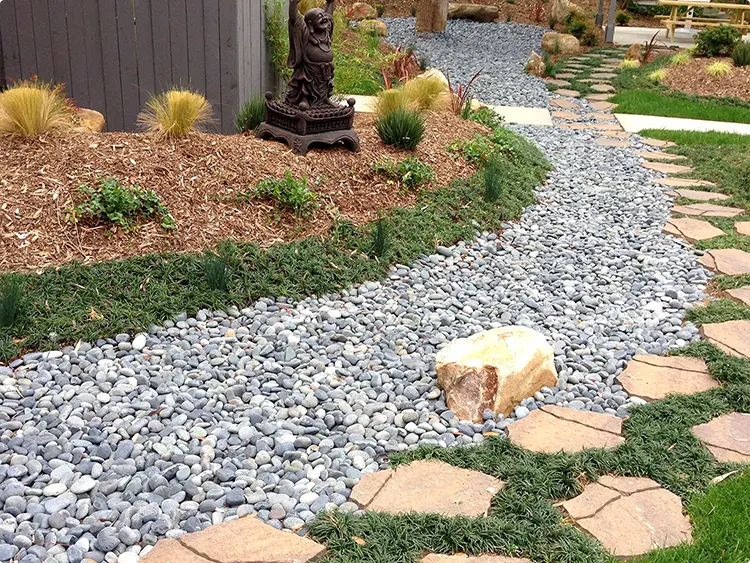
Gray river rocks create a dry creek bed that winds through the grass.
Those natural stone steppers let you cross without getting your feet wet (even though there’s no actual water). The Buddha statue sets the mood.
Golden grasses and mulched beds line the path. It’s peaceful and makes your backyard feel like a retreat instead of just a yard.
Desert Wave Landscape

Gray pebbles flow like a river through beige gravel and around giant boulders.
The natural transition between the two colors mimics water cutting through sand. A few succulents planted here and there keep it from being all stone.
Those massive rocks give the design some weight and make it feel permanent. It’s perfect for low-water climates.
Playful Color Blocking
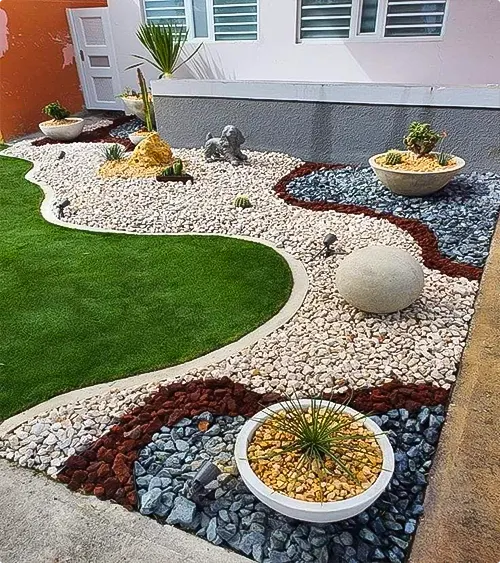
Multiple pebble colors arranged in organic shapes create a fun front yard.
White, brown, yellow, red, and blue stones all get their own sections. Some areas have round planters, others have smooth stone accents.
The green grass islands balance out all the hard surfaces. It’s bold and modern but still feels approachable.
Geometric Pebble Sunburst

White pebbles arranged in triangular sections radiating from a central pot is striking.
Brown clay pebbles fill the opposite triangles to create contrast. Small shrubs anchor each white section.
That terracotta pot in the center with a big tropical plant acts as the focal point. The whole thing looks like a compass rose made of stones.
Cascading Water Feature Garden
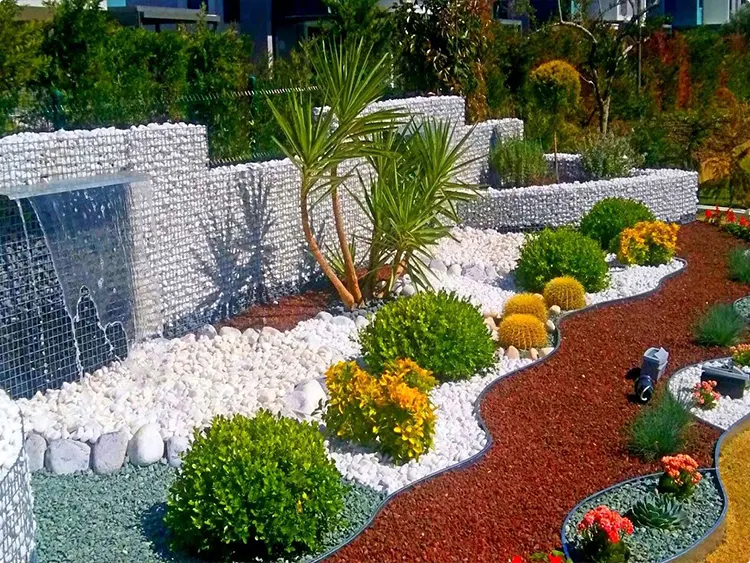
A gabion wall water feature with white pebbles and bright red mulch creates drama.
The white stones define planting beds in curving shapes. Palm trees and round shrubs add different heights and textures.
That red mulch pathway winds through it all and really pops against the white. The water feature becomes the centerpiece that ties everything together.
Pebble Spiral Mosaic
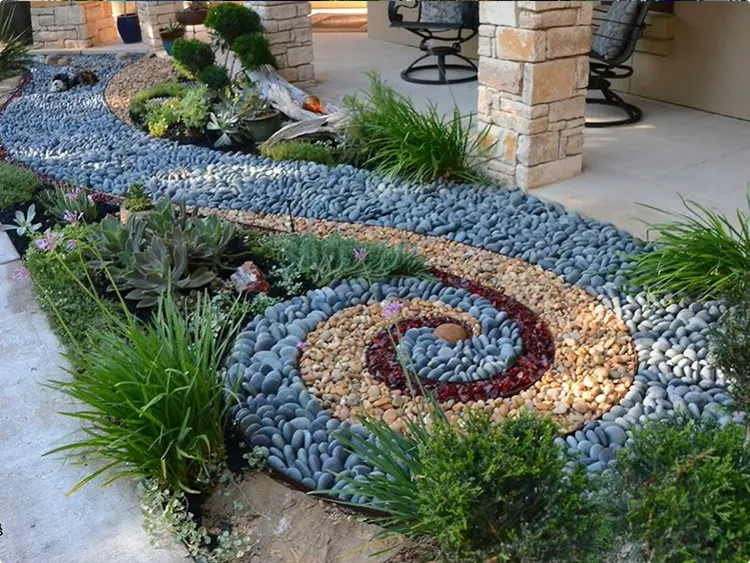
Different colored pebbles arranged in a spiral pattern create actual garden art.
You’ve got blue-gray stones forming the outer ring, then tan, dark red, and more blue working their way to the center. It’s like a mandala made of rocks.
Succulents and grasses planted around the edges soften all that stone. The whole thing sits right by those stone columns, making your patio entrance feel special.
It takes some time to lay out, but once it’s done, it’s basically zero maintenance.
Pebble Mosaic Stepping Stones

Square stepping stones made entirely of pebbles set on edge create texture you can actually see.
The patterns inside each square are different. Some have circles, some have geometric designs, all made by standing those little stones upright.
Tan gravel fills the spaces between the squares. Potted succulents line the path and add color without committing to in-ground planting.
It’s folk art meets landscaping, and it works.
Brick-Edged Pebble Pool

A curved brick border filled with mixed pebbles surrounds a large planter.
The pebbles transition from tan to white in a flowing pattern. That brick edging keeps everything contained and adds warmth.
Orange flowers peek in from the side and break up all the neutral tones. The whole setup creates a focal point around what could’ve been just another pot.
Simple idea, big impact.
Clean Paver Border
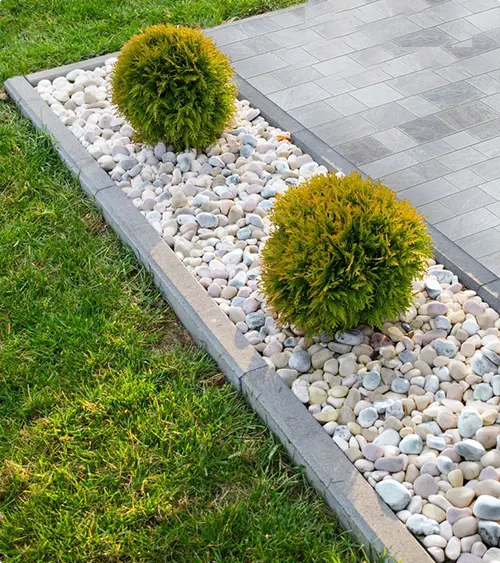
White and gray pebbles contained by pavers create a neat strip between the lawn and patio.
Two round shrubs sit in the pebble bed like little sculptures. The gray pavers frame everything perfectly.
It’s minimal and modern. No fuss, just clean lines and a bit of texture where you’d otherwise have awkward empty space.
Plus it solves that problem of grass creeping onto your patio.
Curved Mulch and Pebble Combo
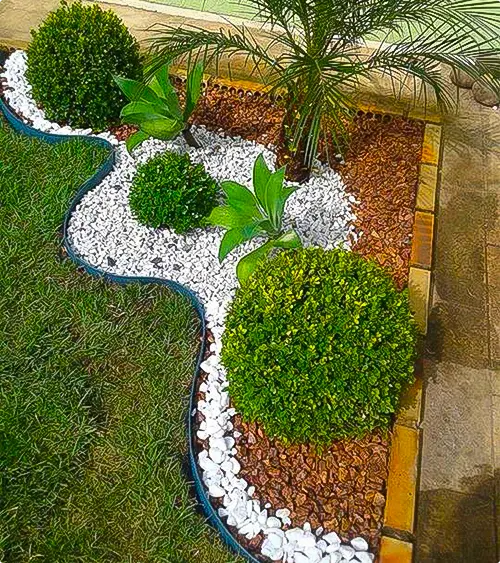
White pebbles flow in an S-curve through brown mulch next to the house.
Round topiaries and tropical plants sit in the mulch sections. The white stones wind between them like a river.
That yellow brick edging defines where the garden bed ends. Everything feels intentional, like someone actually planned this instead of just dumping some plants in the ground.
The curve adds interest to what could’ve been a boring strip along the foundation.
FAQs About Pebble Landscaping Ideas
What size pebbles are best for landscaping?
It depends on what you’re doing with them. For pathways, go with medium-sized pebbles around 1 to 2 inches because they’re comfortable to walk on and don’t shift around too much.
Smaller pebbles work better for detailed designs or filling tight spaces. Larger river rocks are great for borders or making a statement.
Mix sizes if you want a more natural look. Just don’t go too small or they’ll scatter everywhere.
How do I keep pebbles from sinking into the soil?
Landscape fabric is your friend here. Lay it down before you add the pebbles and it’ll keep them from disappearing into the dirt over time.
The fabric also blocks weeds, which is a huge bonus. Make sure it’s actually landscape fabric, not just any old plastic sheet, because you need something that drains water.
Add enough pebbles on top, at least 2-3 inches deep. A thicker layer stays put better and looks fuller.
Are pebbles cheaper than mulch?
Upfront? No, pebbles cost more. But they last way longer than mulch, which breaks down and needs replacing every year or two.
So over time, pebbles can actually save you money. Plus you’re not buying new bags of mulch every spring.
If budget is tight right now, start with pebbles in high-visibility areas and use mulch everywhere else. You can always add more rocks later.
Do pebbles get hot in the sun?
Yeah, they do. Light-colored pebbles stay cooler than dark ones, but they’ll all heat up on a sunny day.
This matters if you have pets or kids running around barefoot. It also affects plants, so don’t put heat-sensitive plants right in the pebbles.
In super hot climates, consider leaving some planted areas or using pebbles just as accents instead of covering everything.
How do I clean pebbles in my landscaping?
A leaf blower works great for getting rid of leaves and debris. Just blow everything off without moving the rocks around.
For dirt buildup, spray them down with a hose. If they’re really grimy, you can use a pressure washer on a low setting.
Rake them occasionally to keep them looking fresh and evenly distributed. It’s way easier than weeding mulch beds, that’s for sure.
Do pebbles prevent weeds?
They help, but they’re not magic. You’ll still get some weeds popping up, especially if you skipped the landscape fabric.
The fabric is really what stops the weeds. The pebbles just make it harder for weed seeds blowing around to take root.
Pull weeds when they’re small and they come out easy. Way easier than dealing with weeds in a traditional garden bed.
How deep should my pebble layer be?
At least 2 inches, but 3-4 inches looks better and provides better coverage. Too thin and you’ll see the fabric underneath, which defeats the purpose.
For pathways where people walk, go deeper so the pebbles don’t scatter. For decorative areas, 2-3 inches is usually fine.
Just remember, pebbles settle over time, so start a bit deeper than you think you need.
